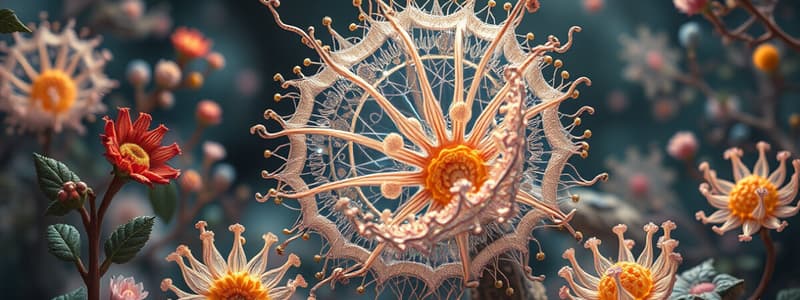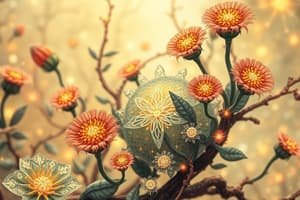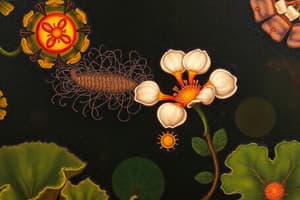Podcast
Questions and Answers
Who was the first scientist to observe living cells in pond water?
Who was the first scientist to observe living cells in pond water?
- Theodor Schwann
- Antonie Von Leeuwenhoek (correct)
- Matthias Schleiden
- Robert Hooke
What is one key characteristic of eukaryotic cells compared to prokaryotic cells?
What is one key characteristic of eukaryotic cells compared to prokaryotic cells?
- They lack a membrane-bound nucleus.
- They have a genome made of RNA.
- They can perform photosynthesis.
- They contain membrane-bound organelles. (correct)
According to cell theory, which of the following statements is correct?
According to cell theory, which of the following statements is correct?
- New cells arise without any pre-existing cells.
- Cells can originate spontaneously from non-living matter.
- All living organisms are composed of multiple cells.
- Cells are the basic unit of structure in all living things. (correct)
What is a significant difference in the size range of animal cells compared to plant cells?
What is a significant difference in the size range of animal cells compared to plant cells?
What term describes organisms made up of a single cell?
What term describes organisms made up of a single cell?
Which of the following accurately describes prokaryotic cells?
Which of the following accurately describes prokaryotic cells?
What are the building blocks of life responsible for all life processes?
What are the building blocks of life responsible for all life processes?
Which statement best describes the nucleus of prokaryotic cells?
Which statement best describes the nucleus of prokaryotic cells?
Which statement accurately describes prokaryotic cells?
Which statement accurately describes prokaryotic cells?
What distinguishes eukaryotic cells from prokaryotic cells?
What distinguishes eukaryotic cells from prokaryotic cells?
Which component is involved in the locomotion of prokaryotic cells?
Which component is involved in the locomotion of prokaryotic cells?
What is the primary function of the plasma membrane in eukaryotic cells?
What is the primary function of the plasma membrane in eukaryotic cells?
Which of the following lists all organelles found in eukaryotic cells?
Which of the following lists all organelles found in eukaryotic cells?
Which characteristic is true about the genetic material of eukaryotic cells?
Which characteristic is true about the genetic material of eukaryotic cells?
How do prokaryotic cells reproduce?
How do prokaryotic cells reproduce?
Which structure is absent in animal cells but present in plant cells?
Which structure is absent in animal cells but present in plant cells?
What is the primary function of the Rough Endoplasmic Reticulum?
What is the primary function of the Rough Endoplasmic Reticulum?
Which structure is referred to as the 'powerhouse of the cell'?
Which structure is referred to as the 'powerhouse of the cell'?
What is the main role of lysosomes in the cell?
What is the main role of lysosomes in the cell?
How many types of plastids are mentioned, and what is one of their functions?
How many types of plastids are mentioned, and what is one of their functions?
The nuclear envelope is composed of how many layers, and what are they permeable to?
The nuclear envelope is composed of how many layers, and what are they permeable to?
What distinguishes Smooth Endoplasmic Reticulum from Rough Endoplasmic Reticulum?
What distinguishes Smooth Endoplasmic Reticulum from Rough Endoplasmic Reticulum?
What is the primary function of cytoplasm in a cell?
What is the primary function of cytoplasm in a cell?
Ribosomes are primarily composed of which two components?
Ribosomes are primarily composed of which two components?
What primary function do lysosomes perform within eukaryotic cells?
What primary function do lysosomes perform within eukaryotic cells?
Which organelle is primarily referred to as the 'Powerhouse of the Cell' due to its role in energy production?
Which organelle is primarily referred to as the 'Powerhouse of the Cell' due to its role in energy production?
What is the main role of the nucleus within a eukaryotic cell?
What is the main role of the nucleus within a eukaryotic cell?
What types of plastids are responsible for the green pigmentation in plants?
What types of plastids are responsible for the green pigmentation in plants?
What is the primary function of ribosomes in a cell?
What is the primary function of ribosomes in a cell?
What is the role of centrosomes within animal cells?
What is the role of centrosomes within animal cells?
Which organelle is responsible for providing structure and rigidity to plant cells?
Which organelle is responsible for providing structure and rigidity to plant cells?
What type of plastid is responsible for storage of starch, proteins, and fats?
What type of plastid is responsible for storage of starch, proteins, and fats?
Flashcards are hidden until you start studying
Study Notes
Characteristics of Living Things
- All living things share common characteristics, including growth, reproduction, response to stimuli, metabolism, homeostasis, and cellular organization.
Definition of a Cell
- A cell is the smallest and basic unit of life, responsible for all life processes.
- Cells serve as the structural, functional, and biological units of all living beings and can replicate independently, earning them the title "building blocks of life."
Discovery of Cells
- Robert Hooke discovered cells in 1665 using a compound light microscope, describing them as small boxes.
- Antonie van Leeuwenhoek observed the first living cells in pond water in 1674 and identified structures in those cells in 1678.
- In 1833, Robert Brown discovered the nucleus in plant cells while studying orchid cells.
- In 1838, Matthias Schleiden and Theodor Schwann formulated the cell theory based on their microscopic observations of plants and animals.
Size and Shape of Cells
- Animal cells typically range from 10 to 30 micrometers (µm) in size, whereas plant cells can measure between 10 and 100 µm.
- Animal cells are generally round and irregularly shaped, while plant cells have a fixed rectangular or box-like structure.
Cell Theory
- Proposed by Theodor Schwann and Matthias Schleiden in 1838.
- Three main points of cell theory:
- Cells are the basic structural unit of all living things.
- All living organisms are composed of cells.
- New cells arise from pre-existing cells.
Types of Cells
- Based on Nucleus Organization:
- Prokaryotic Cells: Simple, single-celled organisms without a true nucleus.
- Eukaryotic Cells: More complex, containing a nucleus enclosed by a membrane.
- Based on Cell Count:
- Unicellular Cells: Composed of a single cell.
- Multicellular Cells: Consisting of multiple cells.
Prokaryotic Cells
- Characterized by the absence of a nuclear membrane, mitochondria, Golgi bodies, chloroplasts, and lysosomes.
- Genetic material is located on a single chromosome without histone proteins.
- Bacteria and Archaea are included in prokaryotes, with cyanobacteria being photosynthetic members.
Prokaryotic Cell Structure
- Capsule: Protective outer covering in bacterial cells.
- Cell Wall: Provides shape and structure.
- Cytoplasm: Gel-like substance containing enzymes and organelles.
- Cell Membrane: Regulates entry and exit of substances.
- Pili: Hair-like structures for attachment.
- Flagella: Whiplike structures aiding in locomotion.
- Ribosomes: Sites for protein synthesis.
- Plasmids: Circular DNA structures independent of chromosomal DNA.
- Nucleoid Region: Contains genetic material.
Eukaryotic Cells
- Possess a true nucleus enclosed within a nuclear membrane, enabling complex cellular functions.
- Includes protozoa, fungi, plants, and animals.
Eukaryotic Cell Structure
- Plasma Membrane: Separates the cell from the environment and contains embedded proteins for substance exchange.
- Cell Wall: Rigid protective layer in plant cells (absent in animal cells).
- Endoplasmic Reticulum (ER):
- Rough ER: Studded with ribosomes for protein synthesis.
- Smooth ER: Lacks ribosomes, involved in lipid production.
- Nucleus: Houses DNA and proteins and oversees cell activities.
- Golgi Apparatus: Packaging and transport of proteins and lipids.
- Mitochondria: Energy production sites, known as the "powerhouse of the cell."
- Lysosomes: Contain digestive enzymes, referred to as "suicidal bags."
- Plastids: Found in plant cells; includes chloroplasts for photosynthesis, chromoplasts for color, and leucoplasts for storage.
- Centrosomes: Organize microtubules for cell division, found only in animal cells.
- Ribosomes: Can float freely or be embedded in the ER, essential for protein synthesis.
- Vacuoles: Fluid-filled organelles aiding in storage and waste management.
Summary
- Cells are fundamental to life, and understanding their structure and function is crucial in biology. Living organisms exhibit a range of cell types, with distinct characteristics that facilitate their various life processes.
Studying That Suits You
Use AI to generate personalized quizzes and flashcards to suit your learning preferences.




